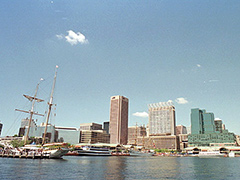Columbia, Maryland: A Community Designed for Quality of Life and Good Basketball

Columbia, Maryland is a newer city and was designed with one purpose in mind: the desire to create an environment without religious or racial problems or segregation of the classes. A Utopian dream that springboarded the success of the Columbia of today. Famed for their indoor and outdoor tennis courts, Columbia boasts some of the most highly attended tennis games in the country. Ice skating is also popular with the residents and they have an incredible array of rinks. They are the proud home of the Goodfellas basketball team and every game is decked out with team colors and the latest in high tech basketball scoreboards attention.
The developer and creator of the concept of Columbia was James W. Rouse. Little would he know that his 1967 planned city community would not only accomplish the dream that he set out with, but surpass it. Rouse wanted the town to overcome all of the stumbling blocks that many areas experienced. He included schools, medical facilities, job opportunities and ease of shopping for the residents. The plan also added to the topic of taxes. The assumption that the commercial interests would cover enough of the property taxes, so that the residents would not be levied heavily. Rouse met with experts from the social sciences to coordinate the very best for Columbia. Meetings were held on the analysis of what would work in a community environment to encourage an enlightened and rich diversity. The designers offered innovative concepts for inter-faith religious freedoms, recreation, and social interaction as just a few of the topics.
The planners were known as The Work Group, and set about creating ten unique villages to reflect their dream community. The area was to maintain a small town atmosphere, while offering the freedoms that were out of reach in so many places in the country. The center would be The Mall in Columbia and a man made lake. The first village known as Wilde Lake Village constructed the Wilde Lake School which was to be set as an example as a national model school. The neighborhoods were design with a combination of single family homes, condos, townhouses, and apartments. There were some that seemed to be leveled at a more exclusive price tag. The goal of all children of all economic backgrounds attending the same school would help to integrate the quality of life they so hoped to achieve.
Imagination and the arts was also part of the community. Street names for each community or village were from famous literary and work of art. It was not uncommon for visitors to stroll through one of the villages and begin recognizing names from J.R.R. Tolkien, Mark Twain or Robert Frost novels. The performing arts were another focus of Rouse’s community, and the Columbia of today offers dinner theatres, music and festivals.
Rouse dreamed of the villages as self-contained communities where people could live, thrive and enjoy their lives. However, his dream took a bit of a turn when the area actually turned into a series of what we call bedroom communities. More akin to the suburbs, with easy transportation access to the malls and big box retail stores, it is not certain that this was the actual idea that Rouse and his planners had in mind. Sports is a favorite past time, with the residents enjoying year round tennis as well as ice skating and basketball. Their basketball scoreboards offer fans and participants the excitement of a game and the relaxation of a day with the family.
Money Magazine has continued to rank Columbia not only in the top ten best places to live, but each year it is raised on the count list. The people of the Columbia area are devoutly protective and proud of their town and much of the original concept of Columbia stands on Rouse’s dream.


